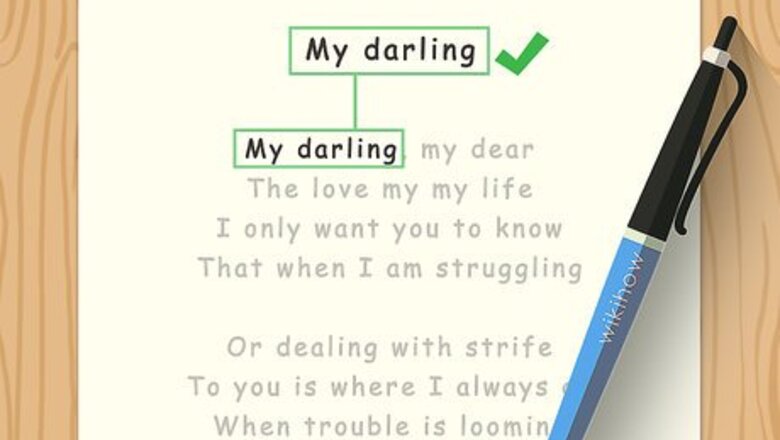
views
Using Keywords and Details in the Poem
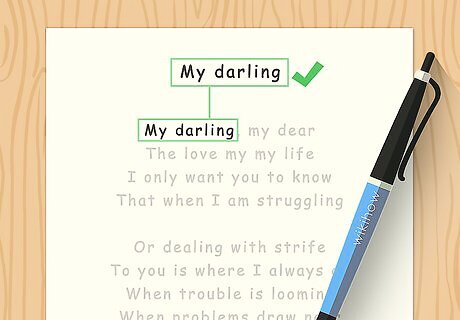
Pick out 1-2 keywords to create a title. Scan the poem for words that jump out at you or feel important. You may notice certain words are repeated several times or referring to throughout the poem. Select 1-2 keywords to create a title that provides the reader with a glimpse of what the poem is about. For example, you may choose keywords like “good” and “sister,” creating a title like “The Good Sister” or “Be good, Sister.”
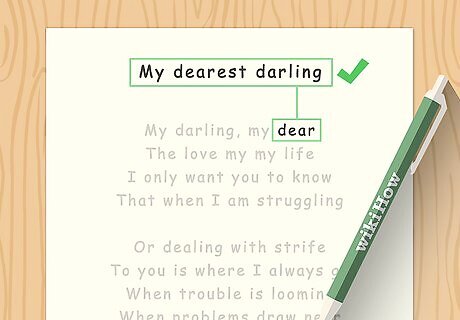
Find a synonym for keywords in the poem for the title. You can also look up the keywords in the poem and find other words that mean the same thing, but have a better sound or ring to them. For example, you may use a synonym for “good” to create a title like, “The Excellent Sister” or “My Precious Sister.”
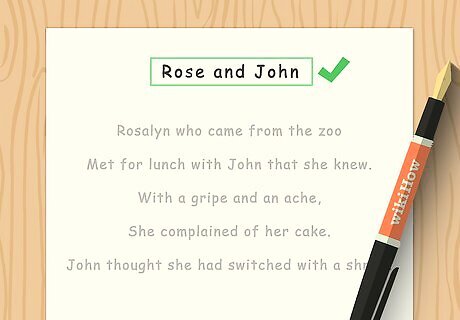
Use the names of characters or places to compose the title. If the poem has a main character or characters who are named, use their names in the title. If there is a main setting or place referred to in the poem, use it in the title to help ground the reader. For example, if your poem focuses on a girl named Eva and her pet swan, you may use a title like “Eva and the Swan.” If your poem is about a Denny’s in your hometown of Sturgis, you may use a title like “Denny’s in Sturgis” or “Denny’s, Sturgis.”
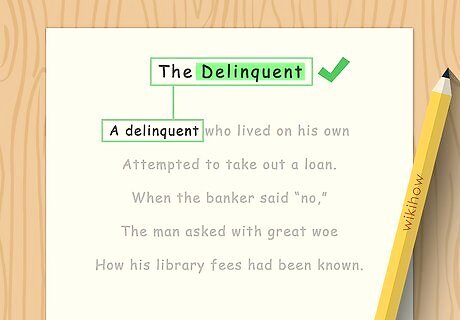
Make a title using strong verbs or adjectives in the poem. Focus on any verbs or adjectives that stand out to you in the poem and highlight them in the title. Find 1 verb or 1-2 adjectives and place them together. For example, you may choose a verb like “beating” and create a title like, “Beating” or “I Beat.” Or you may pick adjectives like “blue,” “dying,” and “stunning” to create a title like, “Dying Blue” or “Stunning Blue.”
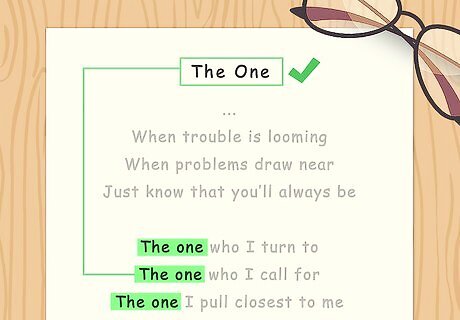
Use a repeated line or verse as the title. If your poem has lines that repeat or a verse that appears several times in the poem, use it as the title. Often, lines or verse that repeats are important and worth highlighting for the reader. For example, you may take a repeating line like “she jumped high in track and field” to create a title like “High in Track and Field” or “She Jumped.”

Create a title using an important or startling image from the poem. Draw the reader in and engage them with an image that is memorable, strange, or interesting. Find an image that feels important in the poem and use it in the title so your reader is encouraged to keep reading. > Avoid picking an image that might give away the crux or turn in the poem. The image should provide some context for the reader but not give any revelations in the poem away. For example, you may use an image of a woman leaping over hurdle on the field, red dirt flying in her wake in the poem, and create a title like, “Red Dirt Flys” or “Woman Leaps.”
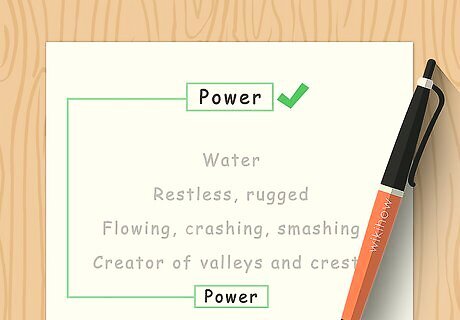
Use the last line of the poem in the title. The last line usually contains key details about the subject matter in the poem. Pick out an image or words in the last line and use them in the title. For example, if you have a last line like, “She ran off the field, in victory,” you may create a title like, “In Victory.”
Referring to the Poem’s Tone and Context
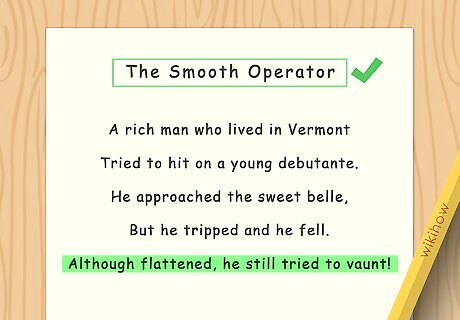
Select a title that matches the tone of the poem. The tone of the poem can be playful, funny, dark, serious, or mysterious. The title should suit the tone so the reader is set up for the poem properly. Using a playful tone for a poem that is serious or mysterious, for example, can throw off the reader and make it difficult for them to get into the subject matter of the poem. For example, if the poem is a playful tale about a little girl named Eva and her pet swan, you may use a title like, “Eva’s Pet Swan” or “Eva’s Friend, a Swan.” If the poem is a dark tale about Eva’s difficult relationship with her pet swan, you may use a title like, “The Problem of the Swan” or simply, “Eva and the Swan.”

Create a title using the time, date, or place you wrote the poem. Think about where you were when you wrote the poem. Glance at the time or date when you finish the poem and use it in the title. This can give the poem context without revealing too much about the poem. For example, you may use a title like, “Monday at the Corner Cafe” or “4:44.”
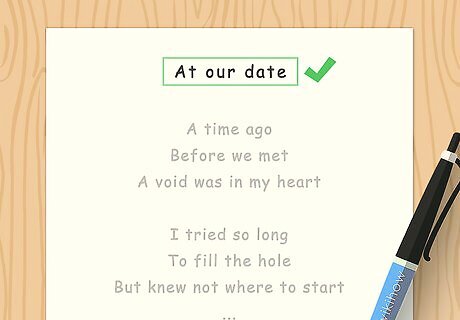
Refer to any images or events that inspired the poem in the title. Think about any images or events that informed your creation of the poem. Maybe you saw an image in the newspaper that inspired you to write the poem or you had a recent experience that motivated you to sit down and write. Include the image or event in the title to provide the reader with a reference point. For example, if you used a newspaper photo, you may refer to the subject in the photo in the title of the poem. Or if you referred to a recent family dinner you went to to create the poem, you may use a title like, “Sunday Dinner” or “At the Dinner Table.”
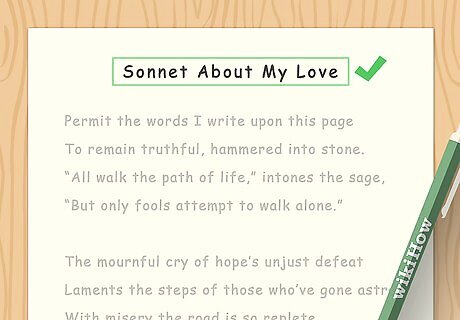
Use the form of the poem in the title. Another option is to name the form of the poem in the title so the reader knows what to expect. You may include the form if it is a popular one or if it is unique, as this can draw the reader in. For example, if you wrote a sonnet about your dog, you may use a title like “Sonnet About My Dog.” Or if you wrote a sestina about your best friend, you may use a title like, “Best Friend: Sestina.”
Formatting the Title
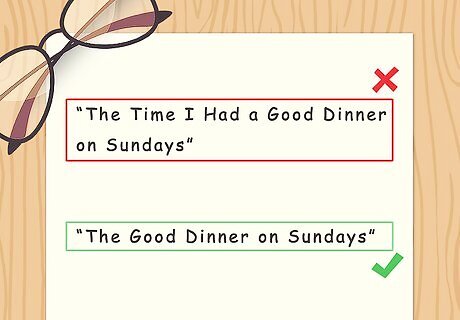
Keep the title short and catchy. Short, catchy titles are usually better, as they are easier for readers to digest. Try to keep the title between 1-4 words at the most so it does not overwhelm the poem. Remove articles like “the,” “a,” and “an,” to shorten the title, unless you feel the must be in the title. For example, rather than use a title like, “The Time I Had a Good Dinner on Sundays,” you may cut it down to, “Good Sunday Dinner,” or “The Good Dinner on Sundays.” In some cases, a longer title may be appropriate if you feel it strongly encapsulates the poem or has a good ring to it.
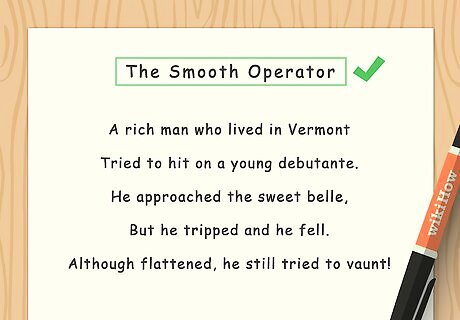
Place the title at the top of the poem and capitalize it properly. The title of the poem should always appear the top of the poem so it is the first thing the reader sees. You should then capitalize all words except for the articles in the poem so it is grammatically correct. For example, you would format a title as: “The Love Song of J.Alfred Prufrock” or “At the Dinner Table.”

Check that the poem has not already been used if you plan to publish it. If you’d like to publish the poem in a journal, magazine, or publication, do a search for the title first online. Make sure no one has already used the title, as it could be considered plagiarism if you go for a title that is already in use. You may also want to change the title if someone else has already used it so your poem can stand out on its own and not be considered for someone else’s work.



















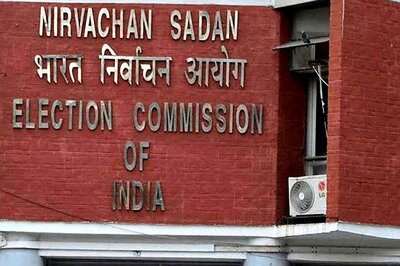
Comments
0 comment